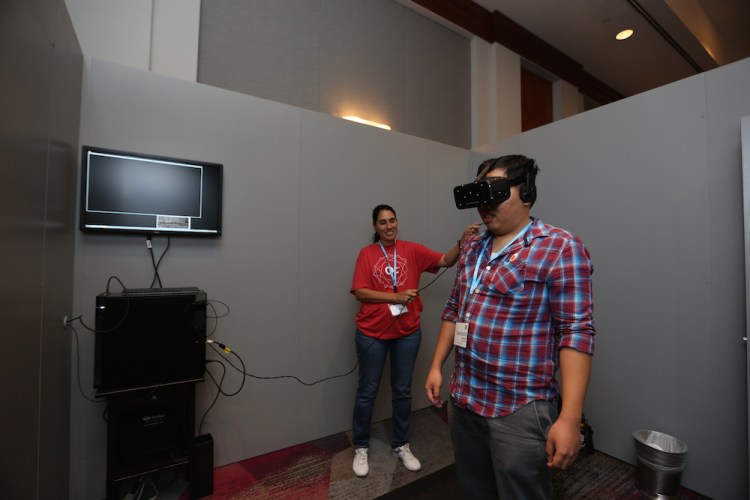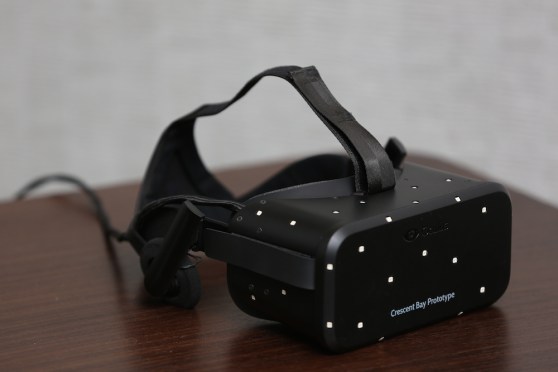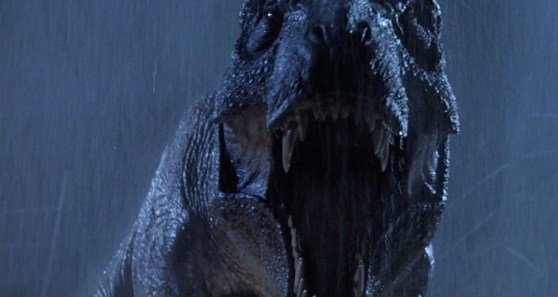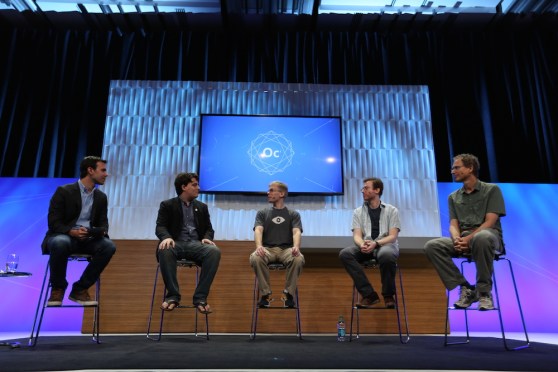From here on out, I want all virtual reality demos to use Crescent Bay. I realize that’s completely unfair and unrealistic for developers who are working with older headsets, but the new Oculus Rift prototype comes amazingly close to achieving the kind of VR we’ve read about or seen in countless sci-fi books and movies.
Oculus VR revealed Crescent Bay at last weekend’s Oculus Connect, the first developer conference that the Facebook-owned VR company has hosted. Crescent Bay is lighter and more powerful than the current “DK2” development kit. Though Oculus won’t sell Crescent Bay headsets (it’s akin to the “Crystal Cove” model from this year’s Consumer Electronics Show), it’s possible that the new features will make it into the next iteration of the Rift or even the eventual consumer release.
“This, for me, really was the thing that changed my view of how big VR can be and how important it’s gonna be,” said Oculus chief executive Brendan Iribe when he addressed everyone in the press room prior to our demo sessions. He added that Crescent Bay is a “very important step” toward the Rift’s consumer version.
I kept those lofty promises in the back of my mind as I headed toward a series of makeshift rooms designed specifically for Crescent Bay’s debut. I love what little time I’ve spent with Rift-compatible games, and I was anxious to try Oculus VR’s latest milestone. What I saw made me both excited and worried about the future of VR technology.
A glimpse of freedom
Trying on Crescent Bay was quite different from my other Rift experiences. Instead of sitting in a chair and having someone give me a controller, I was standing on a black foam mat in the middle of a room. Inside was a PC, a camera perched on a wall (it’s similar to the camera from DK2), and an Oculus employee who handled the fragile prototype herself.
The mat had no effect on the new tech. It was there to let people know how much room they had to move around in before accidentally bumping into one of the walls — the rep told me that at least one unfortunate attendee already did that. I quickly understood why. Since Crescent Bay is the first Rift to have 360-degree head tracking, the VR experience felt a lot more like being in the X-Men’s Danger Room. I could look around virtual sets that, aside from a few imperfections (more on that later), completely engulfed the real world. As soon as I put the headset on, the demo started running through a bunch of different scenarios created in Unreal Engine 4 by Oculus’s content team.
Discovering that freedom of movement (and the way it paired with the superb clarity from Crescent Bay’s higher resolution) was my “holy crap!” moment. While the headset limited my movements to a few square feet, it was just enough to wander around and scrutinize objects from different angles. I first realized this when a miniature Sim City-like metropolis popped into view. It was like looking down at a diorama in a toy store. When I bent down to look underneath it, I could see the bottom of the city, which was just a smooth black surface.
Another part of the demo transported me to a mysterious planet. An alien with a huge noggin stared at me as spaceships soared above us. The creature didn’t move, and I couldn’t walk past it, but its giant eyes did track me. I had fun creeping closer and closer until I was just inches away from its face. It kept trying to talk to me in its own foreign language.
Even more astonishing was my terrifying encounter with a T-rex. We were in a museum, and the hallway shook as the towering dinosaur charged toward me, stopping just short of squishing me with its foot. When it lowered its head, I crouched to get a better view. The T-rex sniffed at its strange finding and roared in my face. I continued to stay down when it decided to move on, turning my head to follow its massive body and tail as it walked over me and disappeared into the darkness. It was like being in a scene from Jurassic Park.
A segment called Showdown was Crescent Bay’s chaotic finale. I was on a futuristic battlefield where armored soldiers aimed their guns at a giant robot at the end of a street. Everything was moving in slow motion. Bullets and missiles rippled through the air, and a ton of shrapnel and sparks flew right by my head. The demo pulled me toward the robot with an invisible cord, so it kind of felt like I was in the world’s slowest 3D movie.
At one point, someone destroyed a car that was in my way, and I watched the vehicle (and the driver that was still inside) hang in midair as it flipped over from the explosion. The demo ended after the robot took a good look at me with its glowing red eye.
Cresent Bay’s not quite there yet
As much as I enjoyed using Crescent Bay, the new prototype has flaws. Iribe said as much when he spoke to the press, but my problem with it goes beyond just graphical glitches. I can’t help but think we’re reaching a point where VR is hitting its own version of the uncanny valley. The better the headsets become at displaying virtual worlds, the more you realize how fake it is because you can’t reach out and touch them.
This was clear during the first part of the demo, when I was examining different pieces of equipment inside some sort of control room. I had this urge to touch them, but of course, all I could grab was air. Another section placed me at the edge of a tall building. Skyscrapers with massive advertisements surrounded me, and I could look down into the streets below. However, it only took two steps forward to break the immersion and realize that I’m not on a rooftop after all.
I’m not saying Oculus needs to simulate what it feels like to fall, but that gap between sight and touch is only going to become bigger as the visual and audio technology improves. Ideally, the Rift would come with some type of input device that’d provide haptic feedback and allow you to use your hands in VR.
Haptics is in a similar situation. At the same panel, Oculus chief scientist Michael Abrash said that haptic feedback is “the hardest problem” to solve. It might take a few years before we even get to the point where VR can give us a passable approximation of what we do in real-life.
Crescent Bay is an impressive feat, but it also shows just how much farther the technology needs to go before we can truly immerse ourselves in VR.
VentureBeat's mission is to be a digital town square for technical decision-makers to gain knowledge about transformative enterprise technology and transact. Learn More





